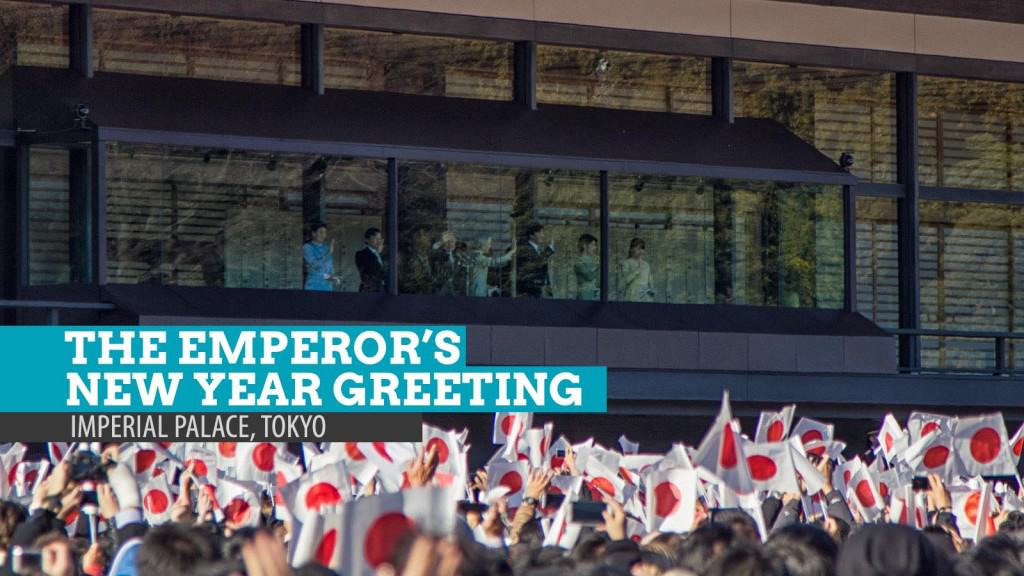The crowd flooded through the gates of the Palace in an extremely organized fashion. There was plenty of space left and right, but people stayed on one side of the road as the queues snaked around the grounds. They were long lines, but they flowed smoothly. The only time we stopped was when we reached the two-step security inspection zone, where officers meticulously frisked and searched the bags of the visitors. Once past it, we sashayed our way over the bridge across the moat toward the Imperial Palace.
The Imperial Palace has received more than its share of criticism. It’s a tourist trap, some claim. Maybe. But not when it’s the second of January.
Banzai!
On this day, the Emperor of Japan Akihito makes a rare public appearance. It is one of the only two occasions when the ceremonial monarch gives a speech from the bullet-proof-glass-protected balcony of the Imperial Palace and addresses the massive crowd below. He is usually joined by the rest of the imperial family.
When I arrived, the central grounds were already packed. Locals and tourists alike had Japanese flags in their hand, awaiting the emperor. I was standing far from the balcony, and the sunlight was making it hard for me to get a clear view. The reflection on the glass was overpowering the interior. I would have moved to a more favorable spot, but the crowd had built so thick behind me that it would be difficult to move around. Before I knew it, waving Japanese flags created a rolling sea of white and red before me. The Emperor had arrived.
Acceding to the throne in 1989, Akihito is the 125th emperor of his line, “the oldest continuing hereditary monarchy in the world”. Although the role and power of the emperor has significantly diminished, he remains the symbolic head of state and highest authority of the Shinto religion.
Next to Emperor Akihito was Empress Michiko. The speech was short, too short. Two minutes, if I’m not mistaken. Or if it was longer, it felt like two minutes. Soon, the man next to me cheered at the top of his lungs, “Banzai!” Everyone followed. The royal family waved and smiled at the crowd, and then gracefully entered the palace again. It was all over.
The getting out of it was actually much tougher. People had to exit the site by batches, so waiting was inevitable.
The Imperial Palace
January 2nd is also one of the two times of the year that the inner grounds of the Imperial Palace is open to the public. (The other date is December 23 for the Emperor’s birthday.) The East Gardens is accessible to anyone for the rest of the year (except Mondays and Fridays).
The Imperial Palace remains the official residence of the Imperial Family. Located at the site where Edo Castle used to stand, the Imperial Palace sits at the center of a large park, scribbled with wide green moats and colossal stone dykes. Two bridges serve as the entrance to the inner section: the Maganebashi (Eyeglass Bridge) and Nijubashi (Double Bridge). Nearby are a number of train stations, of which Otemachi Station is the closest and Tokyo Station the biggest.
The old Edo Castle was completed in 1888, about 20 years after the Tokugawa shogun was vanquished. The capital moved from Kyoto to Tokyo, and a new palace was built as the seat of power only to be destroyed during World War II. The present structure is completely new, modeled after the old one.
Imperial Palace, Tokyo
Address: 1-1 Chiyoda, Chiyoda-Ku, Tokyo, Japan
Contact Number: +81 3-3213-1111How to get to Imperial Palace: Take the train to Otemachi Station (Exit D2), Nijubashi-mae Station (Exit 6), or Tokyo Station (Marunouchi Central Exit). It is a short walk away from here. On January 2 and December 23, when the Emperor makes an appearance, officials assign specific entrances and exits. Please check the official website to know the nearest station to the assigned entry point.
